Duke University in History

Before Trinity College's arrival from Randolph County in 1892, East Campus was the site of Blackwell's fairgrounds and race track. Here, grading begins on Duke's first campus in Durham (near West Main and Broad). (photo courtesy of Duke Archives)

Trinity President John Crowell wrote that even though Durham was less than one hundred miles from Randolph County, it was ten thousand miles away psychologically. A railroad box car transported the old college bell, clock, safe and several thousand books. With the move to Durham, the faculty grew from eight in 1890 to seventeen in 1892 and enrollment jumped from 113 to 180. The contrast between the old campus and the new one was dramatic. In Old Trinity students lived in community boarding houses and the college consisted of a single all purpose building. In Durham, the spacious county fairground where trotting horses raced and steeple chases were held was converted to a park-like campus of three main buildings, seven faculty residences (with indoor plumbing), and athletic fields complete with a grandstand left over from the race track. Note the rail road tracks which ran straight through campus. (Photo and text courtesy of Duke Archives)

Trinity College (ca. 1904): vintage photograph shows Craven Auditorium, library with dome, Alspaugh dormitory, Crowell Science Building and the Erwin Cotton Mills on Ninth Street (in the background).

East Campus in 1909: The Anne Roney Fountain and Stagg Pavilion were built in front of Old East Building in 1902. Anne Roney, Washington Duke's sister-in-law, raised Duke's children after his second wife died. The largest of the American Tobacco Company's twelve warehouses, Smith Warehouse was built across the railroad tracks in 1906 (and now houses Duke offices). Today, the main entrance road into East Campus is farther to the right (closer to Ninth Street). The old fountain still stands (hidden by magnolia trees).

Artist's rendering (postcard): Trinity College with statue of "Wash" Duke looking out to new Main Street entrance. It's likely the central bell tower, with archways connecting Duke East and Duke West, was never built.
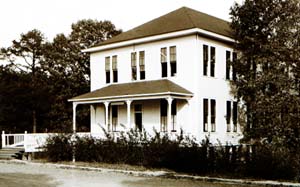
The long narrow bridge-walkway into the Ark forced people
to enter two-by-two; hence, the reference to Noah's Ark. The walkway
had been a gateway to the original fairgrounds. North Carolina's first
college gym and the location of Duke's first basketball games, the Ark
is built of lumber salvaged from the grandstand when Blackwell's old
race track was demolished.

Entrance road into Trinity College (from West Main Street).
Did you know? In the old days, neighbors often called the college "The
University of West Durham."
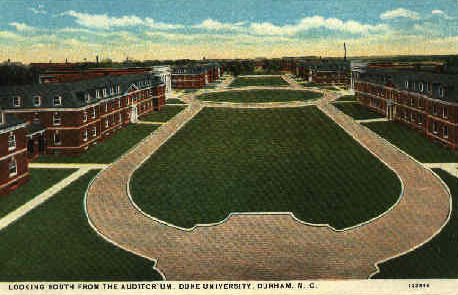
Oval shape of East Campus reflects old Blackwell's horse race track
which once stood here. The old curves of the race
track can still be seen where the ground slopes up behind Bassett, Baldwin,
and Pegram on East Campus.

Old Trinity College
gates at West Main Street entrance. The Washington Duke Building stands
in the background. After this building burned in 1911, no further plans
were made for setting a building directly behind the gates of the college.

Duke University Band practices on the old football field (what is now called East Campus). Asbury Methodist Church, then as now, stands on Markham Avenue at Clarendon.

Before Cameron, before Duke, before the Blue Devils:
Trinity College's first basketball team in 1906.
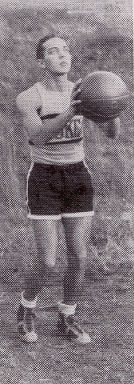 |
Duke basketball player, "Hell On Wheels" Councilor, was dubbed one of Duke's "Three Musketeers" at the 1928 Southern Conference tourney in Atlanta. Following the "humdinger" of a tournament, the Atlanta Journal wrote, "That Duke is going to be a big factor in conference is certain. They have already done enough in basketball, whether they win the title or not, to make their school remembered in Atlanta. In football, wrestling, boxing, baseball and track, the baby member is going to make the old timers look to their laurels. And we don't mean maybe." |
Duke Yearbook advertisements from the 1929 Chanticleer (Volume XVI)

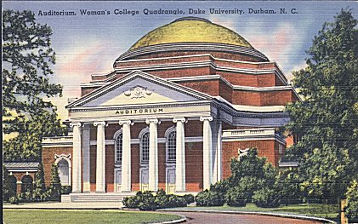
Auditorium, Women's College Quadrangle (now Baldwin Auditorium,
East Campus). In 1896, Washington Duke provided $100,000 for Trinity
College's endowment with the proviso that the college "will open its
doors to women placing them on an equal footing with men." Women had
been admitted to classes regularly since 1892. However, because there
was no dormitory for them, female students were not admitted to residences
on the campus. By requiring the college to open "its doors," Washington
Duke meant to admit them to residence. He then provided the funds to
build a women's dorm (which became in 1897 Duke's first coed dormitory).
In 1930, the rebuilt Trinity College campus -- now East Campus -- became
home to the Woman's College of Duke University. Trinity College for
Men and the graduate and professional schools opened on the newly completed
West Campus. The Woman's College was progressive in many respects because
it set in place parallel student organizations in which women could
take on leadership roles that were normally filled by men. The school
merged with the once all-male Trinity College in 1972. (source: Duke
University Archives)

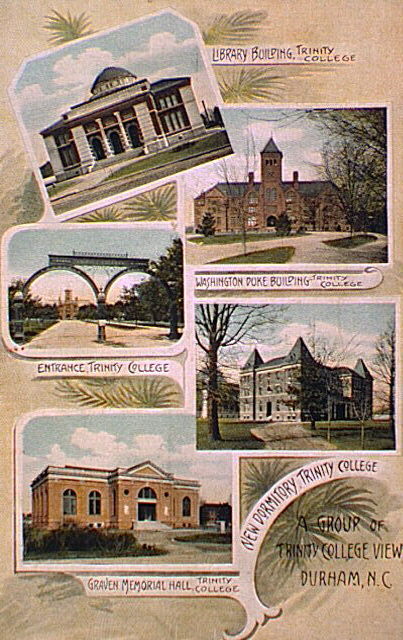
East Campus, Trinity College views (eastern border of Old West Durham).
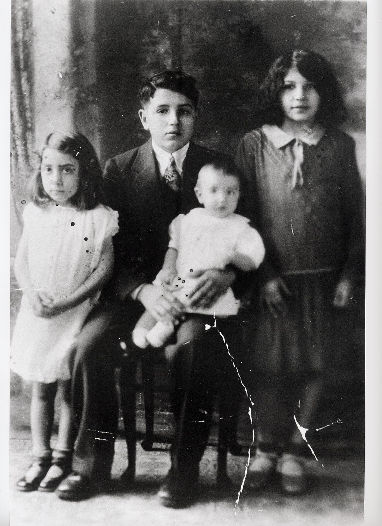
In the 1920s, many Italian families moved to West Durham to help build Duke Chapel and Duke Hospital. Gino, Rina, Mary and Pino Marzocchi lived with their parents at 1206 6th Street (present-day Clarendon). Photo courtesy of Debora Antiga, Gino's grand daughter, who contacted OWDNA from Rome (ca. 1929). More on Duke stonecutters.

Duke's West Campus was once part of the Rigsbee farm.
More than 25 years before construction began on the new campus, a northern
stretch of the farm was sold to make room for the Erwin Mills and some
of the surrounding mill village near Ninth Street.
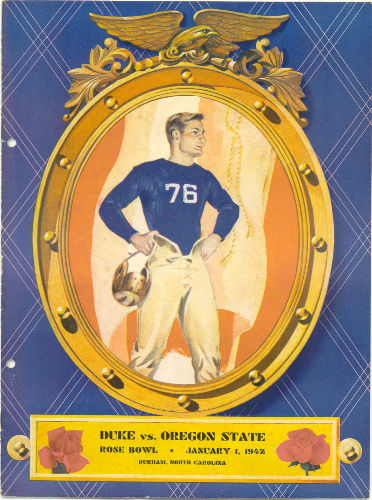
Shortly after Pearl
Harbor, the 1942 Rose Bowl was moved to Durham. Duke's football stadium
was built in the ravine where the Rigsbee's kept their pigs.
Trinity College Timeline in West Durham 1892 -- Trinity College relocated to Durham from Randolph County. Washington Duke and Julian S. Carr persuaded the Board of Trustees to move the college to their progressive "New South" city. Wash Duke contributed $85,000 for buildings and endowment and Carr donated the site, which is now East Campus. 1894 -- John C. Kilgo (1861-1922) elected president of Trinity. 1895 -- Football banned at Trinity College. 1896 -- Booker T. Washington, renowned African-American leader, speaks on campus (the first white institution of higher education in the South to invite him to speak). 1903 -- Trinity College and Professor John Spencer Bassett became forever associated with the history of academic freedom as a result of the "Bassett Affair." In a visit to Durham on October 19, 1905, President Theodore Roosevelt praised Trinity's stand for free inquiry in a speech on campus. 1905 -- Volume 1, number 1 of the student newspaper, The Chronicle, is issued on December 19. 1906 -- Trinity plays its first basketball game. Loses to Wake Forest, 24-10, in the Ark on East Campus (marks the beginning of Tobacco Road rivalries). 1910 -- William Preston Few (1867-1940) is inaugurated president of Trinity. 1912 -- The Chanticleer, a yearbook, is first issued. 1919 -- Trinity's Phi Beta Kappa Chapter is chartered. 1922 -- Chronicle editors begin using the nickname "Blue Devils" for the athletic teams. "Les Diables Bleus" was the nom de guerre of a regiment of French alpine troops widely known for their exploits in World War I. 1925-27 -- Original campus rebuilt with the addition of eleven red brick Georgian-style buildings. 1927-30 -- Gothic campus of native Hillsborough stone built one mile west to house the undergraduate Trinity College for men and the professional schools. 1930 -- The Woman's College opens on East Campus. 1942 -- Duke University and Durham host the only Rose Bowl game ever played away from Pasadena. 1969 -- Terry Sanford (1917-1998), former governor of North Carolina, elected president of Duke. Art Museum dedicated on East Campus. 1993 -- Nannerl O. Keohane (1940- ) inaugurated as Duke's eighth president. 1995 -- The freshman class is housed on East Campus. Living groups in the new dorms are named Randolph, in honor of Trinity's birthplace, Randolph County, and Blackwell, after Blackwell Park, the old Durham fairground that Julian Shakespeare Carr donated as the site for the college's new home. |
For more information on the history of Trinity College and Duke, please visit the University Archives.
